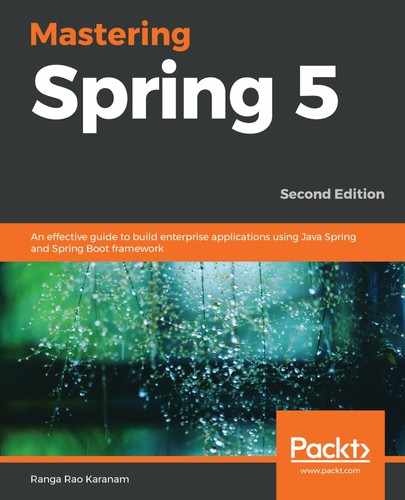Book Description
Build scalable and flexible Rest APIs and microservices using the latest versions of Spring and Spring Boot
Key Features
- Build Java-based enterprise applications using Spring 5.1 and Spring Boot 2.1
- Create high performing, reusable, and scalable enterprise Java applications that are easy to test
- Gain powerful insights into advanced Spring and Spring Boot concepts to develop applications effectively
Book Description
Spring 5.1 is the latest release of the widely used Spring Framework. This book takes you through the evolution of building enterprise-ready applications with Spring and Spring Boot.
Mastering Spring 5 starts with an overview of some of the important Spring Framework features relating to aspect-oriented programming, task scheduling, and scripting with the help of practical examples. You'll learn about the standard dependency injection specification for Java contexts and CDI and how the Spring Framework supports it. You'll gain an understanding of how application architectures have evolved from monoliths to microservices and be able to build your own microservices using Spring Boot. Complete with real-world examples, this book will help you gain powerful insights into Spring Boot 2.1 and learn how to develop cloud-native microservices with Spring Cloud. You'll even explore how to secure a REST API with Spring Security and get started with your first full stack application using React. Furthermore, you'll get to grips with Kotlin fundamentals and build a Kotlin project in Eclipse.
By the end of this book, you'll be equipped with all the knowledge required to develop microservices and full stack applications with the Spring Framework.
What you will learn
- Explore Spring Framework 5.1 features such as AOP, transaction management, task scheduling, and scripting
- Build REST APIs and microservices with Spring and Spring Boot
- Develop a secure REST API with Spring Security
- Build your first full stack React application
- Write efficient unit tests with Spring and Spring Boot
- Understand the advanced features that Spring Boot offers for developing and monitoring applications
- Use Spring Cloud to deploy and manage applications on the Cloud
Who this book is for
This book is for experienced Java and enterprise Java developers and programmers who have a basic understanding of the Spring Framework.
Downloading the example code for this ebook: You can download the example code files for this ebook on GitHub at the following link:https://github.com/PacktPublishing/Mastering-Spring-5.1. If you require support please email: [email protected]
